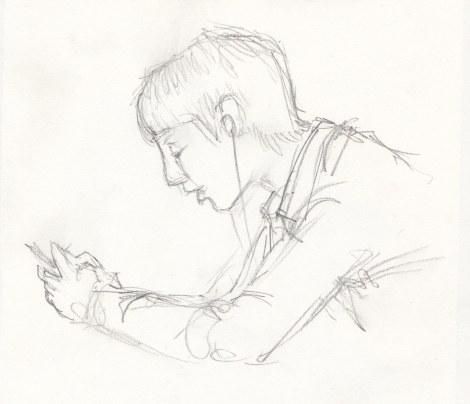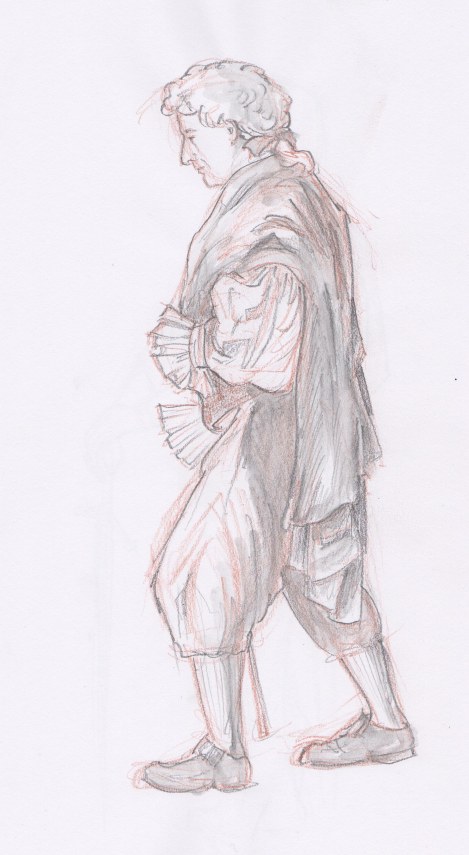There’s an old musician’s joke: A fellow is walking down the street in Manhatten, looking lost. He sees a couple of guys on the street corner, busking, and asks them, “Hey, how do you get to Carnegie Hall?” One of them stops playing long enough to say, “Practice, practice, practice!”
Practice is important for visual artists, too. The more hours you put in, the more you learn, and the more sure of yourself you are. I always say there are no mistakes in art, only learning experiences. If a line or a colour falls short of what you intended, try it again and again until you get it right. Looking critically at what you’ve done and asking how it differs from your vision helps you make a different decision next time.
One way that many artists practice is to do life drawing. You can find sessions in art schools, artist co-ops, and anywhere there are a bunch of artists banding together to hire a model. Usually the models pose in the nude, but sometimes there are clothed or portrait specialty sessions. Practice in drawing the figure is essential if you want to put people in your art, and even if you don’t, it’s great practice for your hand-eye coordination.

“Young Man Thinking Hard” — graphite on toned paper, twenty minute pose
The model expressed in his pose the focus that it took to draw him!
You can also just sit around in public places and draw people, but they usually don’t hold still very long. Except for people texting – I once drew for an afternoon in a food court, and almost everyone there was texting! This got very boring after a while, especially since it seemed everyone was dressed pretty much the same — hoodies and jeans. I also feel nervous when in a public situation that people will notice I am drawing them when I’m in public, so I tend to draw a lot of backs!

“Boy Texting” — this young man was so engrossed that he barely moved during the time I took to sketch this, about five minutes. At least he wasn’t wearing a hoodie, and I got to draw his ear-buds and hair!
The sessions that I go to begin with ten or so gesture poses — these are poses the model holds for one minute, then flows into another one. The idea is to warm up your ability to see and translate it to paper. When I first started I found it incredibly frustrating to try to do a drawing in one minute, but as I did it more, I learned to hone down what I drew to the absolute essentials.

One minute gesture poses. These are pretty exciting to do when you get the hang of it — just trying to capture the essence of the pose in as few lines as possible.
This need to draw really quickly also helps get your left-brain nattering to hush up and let your right-brain functions take over. The left brain is the part that creates symbols for what we actually see, as an aid to more quickly analyzing life as it goes on around us. However, when we are trying to truly see something in order to draw it, this can get in the way. Instead of a tree with a twisty, brown/red/grey trunk and myriad shades of greens and reflected blues from the sky on an irregularly shaped leafy canopy with branches showing through and disappearing again, our left brain wants us to reduce it to a fluffy green lollipop on a brown stick, so that it can get on with paying attention to stuff that is important for our survival. When we are able to get out of left-brain mode and into right-brain mode, we are able to draw far more accurately what we actually see. An excellent, and classic, book on this phenomenon, and how to apply it to your art, is “Drawing on the Right Side of the Brain” (the link is to a review of the newer edition) by Betty Edwards.
One thing about being in right-brain mode is that it feels incredibly relaxing. When you are drawing and lose track of time, the world outside, and the fact that it is dinner time, you’ll know you’ve achieved it. When I’m drawing a model at a session, that’s two hours spent in totally focused right-brain bliss, and that’s the best therapy for an unsettled mind that I can think of! (Not that I’m generally unsettled — though some might call me unhinged — but I always come out of it feeling more grounded.)

“Man Forming a Triangle” — coloured pencils on toned paper, twenty minute pose. Going through my sketches, I was amused to see how many similar poses I’ve drawn over the years — there are only so many ways the human body can fold up, after all. I thought this drawing made an interesting comparison with the previous one.
Drawing from life is also different than drawing from a photo. You are looking at your three dimensional model with binocular vision, and have to make choices about how what you see will translate to two dimensional paper. It is easier to draw from a photo (and it holds really, really still for as long as you want!) because it has already been translated into two dimensions, and all you have to do is copy it. When drawing from life you have more information, and while at first this can seem harder, eventually a photo will come to seem limiting.

“M’Lord Has Lost His Horse” — fifteen minute pose — coloured pencil and water-soluble graphite pencil. A good model can evoke emotions with his or her pose. This poor aristocrat has to trudge all the way home! Notice that you can still see all the scribbly lines I made with the coloured pencil while setting up the sketch, before homing in on where I really wanted the lines with the graphite pencil. I then gave it a quick swipe with a brush for the shadows, since the graphite was water soluble. Great stuff, those pencils.
There is also a tendency with photos to copy slavishly (I’ve noticed this not only in myself, but in my students) rather than create a unique interpretation. I’m not sure why this is, but it possibly has something to do with the fact that the photo is a static thing, and you have all the time in the world to copy every detail. When you’ve only got five, ten, or twenty minutes to capture a likeness, and then that pose, that lighting, will be gone forever, it really sharpens up your ability to make fast choices about the marks you are going to put on the paper!

“Girl in a Hat” — drawing drapery and clothes is way more challenging than just drawing the figure. The underlying structure has to be right, and experience drawing the nude figure is a tremendous help in this. Practicing just drawing heaps of cloth helps too! One of these days I’m going to procrastinate doing the laundry by drawing the basket full of clothes!
If you like to draw, I hope this has inspired you to try figure drawing if you haven’t already. If you have you know what I’m talking about! I’d love to hear your stories in connection with any of this — your experiences with drawing models, the first time you reached drawing bliss, ways that you practice your drawing skills — please comment!




Pingback: Drawing-a-Day 7 — building on a gesture sketch | Karen Gillmore Art·
Love these…love drawing people but find hands difficult.
LikeLike
Thanks, Marketa! Lots of people find hands hard — I used to too, and occasionally some odd position will still stump me. The way I got over it was to start drawing them as mittens because that was less complex; then I started thinking of the palms of the hands as little square boxes that I could put in perspective and attach stick like fingers to, to be fleshed out when I had them positioned rightly. As with everything else, though, it’s practice… oops, I said that already… 😀
LikeLike
Yep! I make them too small…hahaha
LikeLike
That would certainly disguise them! OK, here’s an exercise — draw the hands twice as big as you think they ought to be. Make great big hands on little tiny people. Make the hands express what you would normally use the faces to express. Use your own hands for reference. Use a mirror. Eventually drawing hands will start to feel natural and you can shrink them back to normal again!
LikeLike
Thank you!
LikeLike
Reblogged this on sketchuniverse and commented:
🎨 WELL DEARS! NOW IT’S TIME FOR SKETCHING UNDRESSED PEOPLE. ANATOMY IS THE MOTIF.
LikeLike